Cycling your new fish tank is the first important step towards becoming successful in the fishkeeping hobby. But how do you know when your fish tank has cycled?
Well, I’ve cycled over a dozen of fish tanks, and in this article, I’m going to tell you when you can say your fish tank is cycled and is ready to add fish in it.
After testing your aquarium water for ammonia and nitrite and nitrate, if the reading shows 0 ammonia, 0 nitrite, and some nitrates then your fish tank is cycled. Cycling a new tank usually takes between four to six weeks.
Cycling your fish tank can take a long time. And I know after testing your aquarium water it can be very frustrating not to see 0 ammonia and 0 nitrite levels. But cycling your fish tank is a very important step in creating a healthy environment for your fish.
Besides, there are some mistakes that beginners make that can further increase the time to cycle a fish tank. I’ll cover these mistakes later in the article.
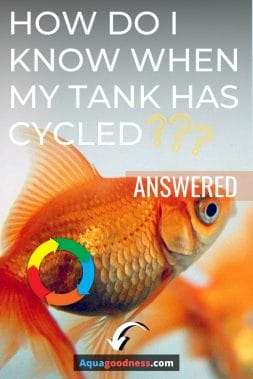
Table of Contents
How do I know when my fish tank has cycled if I’m doing fishless cycling?
If you’re doing fishless cycling, you’re using some type of ammonia source to add to your fish tank.
So, to know if your fish tank is cycled or not, you’ll need to add ammonia in your fish tank and wait for about 24 hours.
Just make sure that the ammonia you’re adding is not more than 5 ppm because it can stall the nitrogen cycle.
After 24 hours, perform an ammonia, nitrite, and nitrate test of your aquarium water. You can easily do these tests by using an aquarium water test kit.
If you don’t already have a test kit then I recommend the API master test. It is a pretty accurate test kit and it comes with helpful instructions to use it.
You can check its reviews and latest price at Amazon here.
After performing the tests, if the test shows 0 ammonia level, 0 nitrite levels, and some nitrate levels then you can conclude that your fish tank is cycled!
At this point, your fish tank contains beneficial bacteria that can convert ammonia which is harmful to the fish into nitrites (which is also harmful).
But your tank will also have good bacteria that can convert nitrite as it appears into nitrate.
Now nitrate is less harmful to the fish and your fish can tolerate nitrate levels as high as 40 ppm!
Should I Do a Water Change During Fishless Cycling? (Does It Affect Cycle)
How do I know when my fish tank has cycled if I’m doing fish-in cycling?
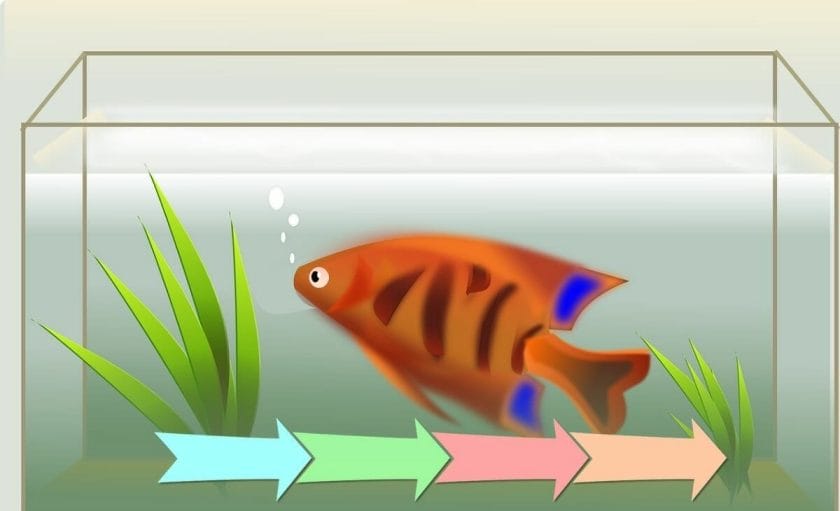
In fish-in cycling, you’re using uneaten fish food and waste produced by the fish as an ammonia source to start the nitrogen cycle in your fish tank. It generally takes about six weeks to cycle a fish tank with the fish-in cycling method.
In fish-in cycling, the behavior of your fish can tell you whether your fish tank is cycled or not.
After about six weeks of adding the fish to your tank, if you did water change only once in two weeks and you still don’t see any signs of stress in your fish then you could say that your fish tank has cycled.
At this point, probably your fish tank has the beneficial bacteria that convert the harmful ammonia and nitrite into less harmful nitrate.
But to be sure of whether your fish tank is cycled or not, it is a good idea to test your aquarium water for ammonia, nitrite, and nitrate levels.
You can easily perform the tests using an aquarium water test kit. I recommend the API master test. It is a very accurate test kit and it comes with helpful instructions to use it.
You can check its reviews and latest price at Amazon here.
So, after doing the next water change of the tank, wait for about 24 hours and then test your aquarium water for ammonia, nitrite, and nitrate using the test kit.
If the test shows 0 ammonia, 0 nitrite, and some nitrate then it is a very good early sign that your fish tank is cycled.
However, just to be 100% sure you should perform the tests daily for the next 7 days.
After performing the tests for 7 days, if you see 0 ammonia, 0 nitrite, and nitrate levels increasing every day for the 7 days then you can conclude that your fish tank is cycled.
What Happens if You Don’t Cycle a Fish Tank? (Is It Really Necessary)
Is there any way to speed up the cycling process?
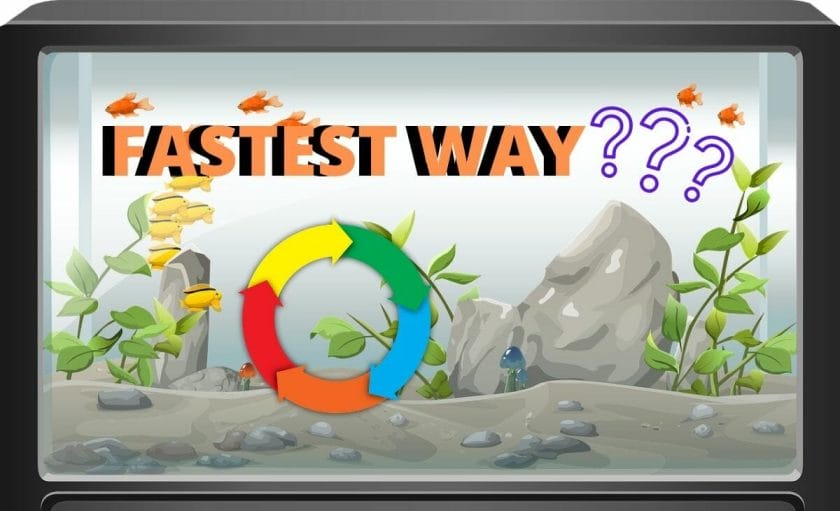
There is a way to instantly cycle your fish tank!
Cycling a fish tank is basically housing beneficial bacteria that can convert harmful ammonia and nitrite into less harmful nitrate.
If you’re cycling your fish tank by doing fish-in cycling or fishless cycling by “traditional/organic/natural” way i.e. first adding ammonia into the tank. Then after some time, beneficial bacteria will appear in your tank which will convert ammonia into nitrite.
After that, another type of beneficial bacteria will grow in your tank and it will convert the nitrite into nitrate.
Then this method is going to take a while to complete. It usually takes around four to eight weeks to complete the nitrogen cycle process using this method.
Actually, I’ve written a detailed article on this topic. You can check it out here.
But instead of waiting for the beneficial bacteria to grow in your tank organically, what if you can add the beneficial bacteria to your aquarium directly!
Fortunately, there are a few ways to introduce the beneficial bacteria in your new tank. And if you do it correctly, your fish tank will be instantly cycled!
Will Live Plants Help Cycle My Tank? (Answered)
How to introduce beneficial bacteria in your new fish tank and cycle it instantly?
Basically, you can add beneficial bacteria from an established aquarium into your new tank. Or there are a few brands that sell beneficial bacteria in bottles. You just need to empty the bottle in your tank to add the beneficial bacteria in your tank.
How to add beneficial bacteria from a cycled aquarium?
Beneficial bacteria create their colonies in the filter, specifically, on the filter media of a cycled aquarium.
So if you add the filter or filter media from a cycled aquarium in your new aquarium then it will add the beneficial bacteria in your new tank. And this will instantly cycle your new fish tank.
Now a potential problem with this approach of cycling a fish tank is that when you add the filter or filter media from a cycled aquarium in your new tank if the cycled aquarium is infected with harmful bacteria and viruses then you may also add those harmful bacteria or viruses in your tank.
So the solution for this problem is you should get the filter or filter media from a trusted source.
What Is The Fastest Way To Cycle A Freshwater Fish Tank? (4 Easy ways)
Adding a bottle of beneficial bacteria in your new tank
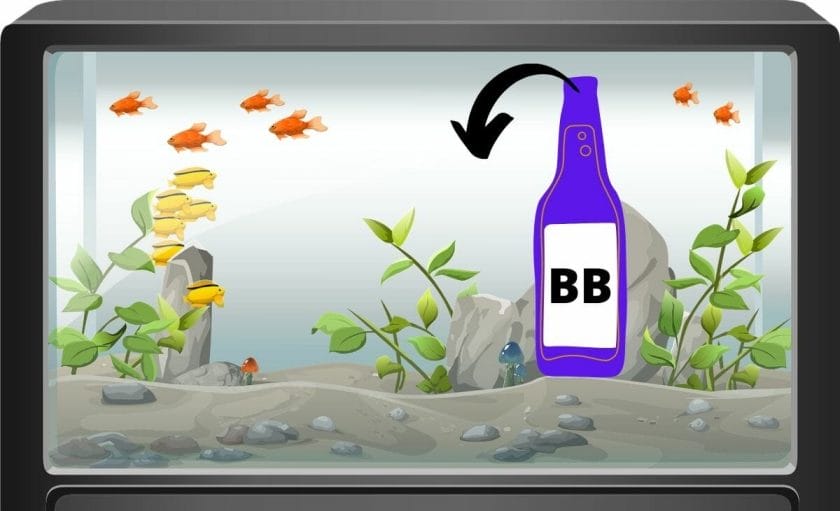
There are several brands that sell beneficial bacteria in small bottles. You just need to empty the bottle in your new tank and you’ll have beneficial bacteria in your tank.
However, the problem with these bottles is that, sometimes, the beneficial bacteria in the bottle are dead! And the dead beneficial bacteria are not going to cycle your fish tank.
The thing is, beneficial bacteria are living organisms that require food and oxygen to survive. And they may not get the food and oxygen in the bottle for a long time.
So sometimes what happens is that, by the time you empty the bottle in your new tank the bacteria are dead.
Now, this doesn’t happen always but it does happen a lot of times.
So with this approach of cycling a fish tank, unfortunately, you’ll just need to rely on your luck!
So get a bottle of beneficial bacteria. Add it in your tank. Then add ammonia to your tank.
Now, wait for about 24 hours.
After 24 hours test your aquarium water for ammonia, nitrite, and nitrate.
If the test shows 0 ammonia, 0 nitrites, and some nitrate levels then you can say that the beneficial bacteria are alive and working!
Below are some of my recommended beneficial bacteria bottles. People had good experiences with them.
- Dr.Tim’s Aquatics Freshwater One & Only Nitrifying Bacteria- See its reviews at Amazon here
- Fritz Aquatics FritzZyme 7 Nitrifying Bacteria for Fresh Water Aquariums- See its reviews at Amazon here
Mistakes that can slow down the nitrogen cycle in your fish tank
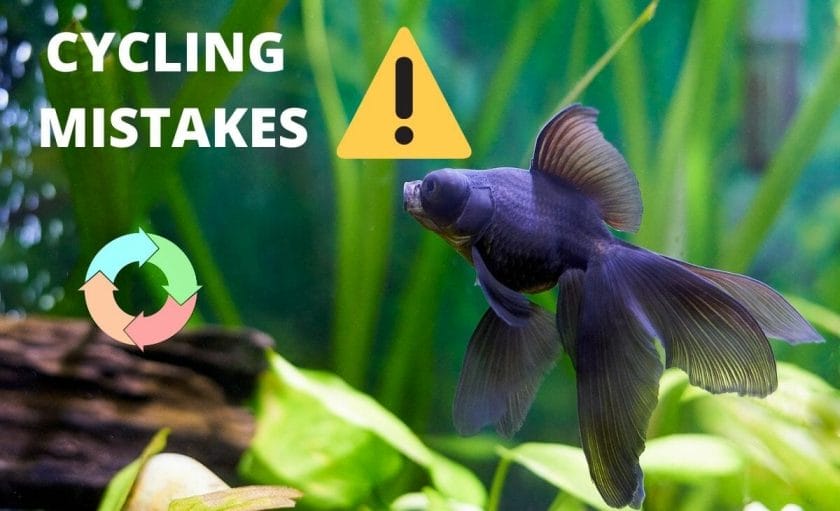
There a few mistakes that you may not aware of that can slow down or stall the nitrogen cycle of your aquarium.
1. Not maintaining the pH
If the pH of the water of your aquarium is lower than 7 then it can slow down or stall the nitrogen cycle in your aquarium.
To avoid this mistake, you should regularly check the pH of your aquarium water using a test kit.
If you found the pH is lower than 7 then doing a water change of about 20% of your aquarium water can increase the pH of your aquarium water.
2. The fish tank contains a lot of ammonia
Ammonia is food for beneficial bacteria. But a lot of ammonia i.e. more than 5 PPM (parts per million) is toxic for them. So if your fish tank has ammonia of more than 5 PPM then it can stop the nitrogen cycle.
That’s why you should check the ammonia levels in your fish tank after adding ammonia in your tank and make sure that it is under 5 PPM.
Or in case you’re doing fish in cycling or using any other ammonia source instead of pure ammonia like fish food then you should check the ammonia levels in your tank on a daily basis.
Can I Use Fish Food to Cycle My Tank? (and How It Works)
How to introduce a fish in your newly cycled aquarium?
Once your fish tank is cycled, you can then add fish in it.
However, you should not directly add the fish in your tank.
Before introducing the fish to your newly cycled tank, you’ll need to acclimate the fish.
Acclimating a new fish is very important because it can prevent the sudden shock that the new fish could get if you introduce it right away in your fish tank.
How to acclimate a new fish?
To acclimate a new fish just hold the polybag that contains the fish floating over the surface of the water of your aquarium for about 20 to 30 minutes.
This will slowly balance out the temperature of the water in the polybag with the temperature of the water of your aquarium.
This is important because if there is a big difference in the temperatures of the water and you directly introduced the fish in your tank then it can cause severe shock to the fish.
Another thing to keep in mind while adding a new fish in your tank is that you should not add the water in the polybag in your fish tank.
This is especially important if the fish is shipped to your place. Because, in this case, probably the fish is in the polybag for a few days and thus the water may contain a lot of fish waste and so ammonia in it.
Besides, the water may also contain harmful bacteria and viruses!
So, the right way is to add the fish in your tank by using a fishnet.
The following video shows you exactly how to acclimate your new fish and put it in your tank the right way.
Conclusion
During the fish tank cycling process, you should regularly test the water in your fish tank for ammonia, nitrite, and nitrate.
When the tests started to show 0 ammonia, 0 nitrites, and some nitrate then you can conclude that your fish tank is cycled.
If it’s been a few weeks and still your fish tank is not cycled, don’t stress out about it. It usually takes four to eight weeks to cycle a fish tank.
Just make sure you’re not doing the mistakes that I mentioned in this article that can slow down or stop the nitrogen cycle.
Once your fish tank is cycled, make sure to acclimate the new fish before adding it in your tank. The video I’ve included in the article will help you add your new fish to the tank the right way.
I hope you found this article helpful.
If you do, please share it with anyone who’s just starting out in the hobby.
Happy fishkeeping!
Related article: